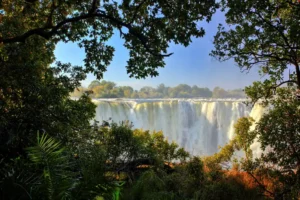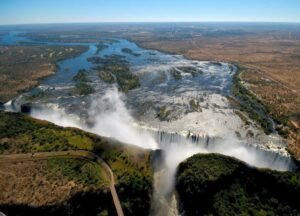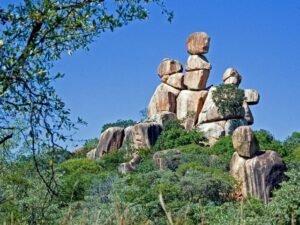



When people think of Zimbabwe, Victoria Falls often leaps to mind. Yet, the tapestry of Zimbabwe’s landscapes, wildlife, and cultural heritage is far richer and more varied than even that iconic “smoke that thunders.” In 2025, the best places to visit in Zimbabwe are not just spectacular attractions; they are living stories—of ancient kingdoms, resilient communities, delicate ecosystems, and wilderness journeys that change your perspective.
In this article, we will explore numerous sites that combine nature and culture—from soaring waterfalls and rugged national parks to sacred hills, archaeological ruins, and burgeoning urban arts scenes. I aim to provide you not just with a travel guide but with a narrative nonfiction lens: stories behind the places, voices of the land, and contextual knowledge for further study. Wherever possible, I cite factual sources and link to further reading. (If you want a companion piece on neighboring Zambia, check out this internal link: https://jetsettrail.com/the-best-places-to-visit-in-zambia/.)
While this article is long and detailed, you can travel section by section: start with the big highlights (Victoria Falls, Hwange, Great Zimbabwe), then dive deeper into lesser-known corners like Matobo Hills, the Eastern Highlands, and cultural hubs like Bulawayo and Harare. Let the stories of Zimbabwe draw you in.
1. Victoria Falls & Zambezi River — The Crown Jewel
1.1. The Magnificence of the Falls
Of all the best places to visit in Zimbabwe, Victoria Falls (also known locally as Mosi-oa-Tunya, “the smoke that thunders”) remains the most iconic and globally renowned. This cascading curtain of water stretches about 1,708 meters (5,604 feet) across the Zambezi River and plunges about 108 meters. Viator+2Wikipedia+2
In the wet season (February–May), the falls are at full volume, sending up immense spray that can be seen from tens of kilometers away. In the dry season, much of the rock face becomes exposed, revealing geological layers and permitting vantage points you might never see otherwise. This dynamic contrast is part of what makes the falls endlessly captivating.
From the Zimbabwean side, there are multiple viewpoints and walking trails through a rainforest sustained by the water’s mist—a micro-ecosystem of ferns, palms, lianas, and mahogany trees unique to the spray zone. Wikipedia
1.2. Victoria Falls National Park & Rainforest
The Victoria Falls National Park covers the stretch along both banks (Zimbabwean side) of the Zambezi River around the falls. It preserves both the geological wonder of the falls and the adjacent rainforest. Wikipedia
Walking trails, observation decks, and lookout points allow you to peer over the edge from many angles; each gives a different sensory experience—the thunder, the tremor, the cool spray. Wildlife—occasionally elephants, buffalo, antelope—can graze near the forest edges. Crocodiles sun themselves upstream; riverbank birds flit through the canopy.
One memorable narrative: early explorers named the falls after Queen Victoria, but local Batonga people already called it Mosi-oa-Tunya. In 1905, the Zimbabwean landscape was already deeply interwoven with colonial claims, yet the Indigenous name persists in everyday usage and in modern Zimbabwe’s tourism branding.
1.3. Adventure Activities on the Zambezi
To visit the best places to visit in Zimbabwe is not just to stand at viewpoints but to immerse and engage. Victoria Falls is also an adventure hub:
-
Helicopter or microlight flights over the falls offer aerial views of gorges, spray clouds, and the swirling Zambezi below.
-
White-water rafting in the Batoka Gorge to the base of the falls is gutsy and thrilling during certain months. Viator+1
-
Bungee jumping and bridge swings off the Victoria Falls Bridge let you feel the plunge in narratives of personal invitation to risk and beauty.
-
Sunset cruises on the Zambezi River upstream offer peaceful wildlife watching (hippos, crocs, birds) as the sun dips.
-
Devil’s Pool is a natural rock pool at the rim (on the Zambian side) that, in dry months, allows you to lean over the edge. Note: crossing to the Zambia side may be required depending on water levels and border controls.
All of these activities anchor Victoria Falls as first among the best places to visit in Zimbabwe, not merely as spectacle but as immersive experience.
1.4. Across the Bridge: Transnational Experiences
The Victoria Falls Bridge connects Zimbabwe and Zambia. Many travelers experience a dual-country border trip in a day: walk across the bridge, peer from Zambian viewpoints, take a train, or do cross-border rafting. The contrast between sides—Zambia’s lower spray, Zimbabwe’s more dramatic viewpoints—offers a layered narrative of colonial borderlines drawn across a continuous ecosystem.
Connecting you to the region, the internal link on Victoria Falls also ties to broader explorations: see the internal link here for visiting Zambia’s side of the falls: https://jetsettrail.com/the-best-places-to-visit-in-zambia/.
Thus, Victoria Falls sits at the crossroads of nature and culture, border and river, past and present.
2. Hwange National Park — The Elephant Kingdom
2.1. Ecology, Scale & Wildlife
Moving south from the Zambezi basin, Hwange National Park is Zimbabwe’s largest—and arguably most accessible—game reserve. It spans over 14,650 km² and holds one of the world’s most concentrated elephant populations (some estimates exceed 40,000 individuals) alongside a vast suite of mammals and birds. On The Go Tours+2Goway Travel+2
Hwange lies between Bulawayo and Victoria Falls, making it relatively reachable. Yet compared to more trafficked safari parks in East Africa or South Africa, Hwange often feels remote and less crowded—a gem among the best places to visit in Zimbabwe for serious safari seekers.
You’ll find lions, leopards, wild dogs, hyenas, buffalo, giraffe, zebra, antelope species, and over 400 bird species. Viator+2On The Go Tours+2
2.2. Safari Routes & Private Concessions
Hwange’s tourism is organized around main roads and a network of private concessions and camps. In the dry season, many animals concentrate at water holes, making for dramatic photography and extended viewing. In contrast, the wet season brings broader dispersal and lush habitat, but viewing becomes more challenging.
Some of the camps offer walking safaris, night drives, and close-by excursions into less-visited zones. For narrative travelers, listening to guides’ stories of tracking, poaching recovery, or local community relations is as enriching as the sightings themselves.
For example, Linkwasha Camp (rebuilt in recent years) is designed with sensitivity to cooling, natural light, and open terraces that blend guests with the surrounding landscape. Architectural Digest
Hwange provides a broad canvas: for those who want to chase the Big Five, encounter elephant herds, or dive deep into predator ecology, this park is a pillar of any Zimbabwe itinerary.
2.3. Conservation Challenges & Community Interfaces
No narrative of Hwange is complete without acknowledging challenges. Poaching, water stress, and human-wildlife conflict loom large. Many communities fringe the park; locals may face crop damage or competition for grazing. Conservation strategies increasingly involve community-based natural resource management (CBNRM) schemes, where locals share in tourism revenue and decision making.
Visiting as a respectful traveler means supporting lodges that invest in anti-poaching, community health or schooling, and environmental education. The stories of how wildlife rangers operate, how local communities negotiate land rights, and how dryland ecology shifts under climate stress all deepen your understanding beyond wildlife snapshots.
3. Mana Pools National Park — Wild Africa on Foot
3.1. UNESCO World Heritage & Wilderness
Situated along the southern banks of the Zambezi River in northern Zimbabwe, Mana Pools National Park is a UNESCO World Heritage site and widely regarded as one of Africa’s most authentic wilderness areas. Viator+2Goway Travel+2
The name “Mana” means “four” in Shona, referencing four oxbow lakes formed by meanders of the Zambezi. The terrain is open floodplain interspersed with woodland and riverine forest. The park offers low human presence, minimal infrastructure, and high-intensity nature immersion.
Because it is less commercialized, Mana Pools qualifies as one of the best places to visit in Zimbabwe for travelers seeking solitude and raw nature.
3.2. Walking Safaris & Canoe Trips
Unlike many parks where game drives dominate, Mana Pools is famous for walking safaris and canoe safaris—especially in the dry season. Walking with a wildlife-trained guide, you trek across floodplains, follow spoor, and feel the pulses of animal life at close range. Canoeing down the Zambezi, you drift past hippos and crocs, birds and riverbank mammals, sequence by sequence.
These modes of travel elevate the narrative nonfiction experience—you’re not just observing wildlife; you are entering a living ecosystem, tracking footprints, hearing bird calls, discerning the river’s flow.
The combination of walking, canoeing, and nightly camping in remote camps makes Mana Pools a must for serious adventurers.
3.3. Wildlife — Hippos, Crocs, Predators
Mana Pools supports dense hippo and crocodile populations, often seen in the river and along banks. During the dry season, elephants and buffalo cross the floodplains. Predators—lions, wild dogs, hyenas—prowl the edges of open plains and riverine forests.
Because visitor numbers are lower, encounters can feel raw and unscripted. Night sounds of predator calls and distant spleens echo across the floodplain. This is wilderness in its immersive form. For any list of the best places to visit in Zimbabwe, Mana Pools represents the wild beyond the guidebook.
4. Great Zimbabwe Ruins & Masvingo Region
4.1. History of the Kingdom of Zimbabwe
Moving from nature to culture, the Great Zimbabwe Ruins (near Masvingo) stand proud as one of Africa’s greatest ancient stone cities. Between the 11th and 15th centuries, the Kingdom of Zimbabwe built monumental dry-stone walls, towers, and enclosures—without mortar—that endure to this day. On The Go Tours+2Far and Wild Travel+2
This site is central to the modern national identity: the country itself is named for this ancient polity. Its sophistication, trade links (with Arab, Persian, and Indian Ocean traders), and architectural mastery invite research into precolonial African statecraft, trade networks, and archaeology.
4.2. Layout & Interpretation
Walking the ruins, you’ll encounter:
-
The Great Enclosure, the largest ancient stone wall in sub-Saharan Africa.
-
The Hill Complex, a fortified plaza with panoramic views.
-
The Valley Ruins, homes and workshops of ordinary citizens.
-
Interpretive signs, guided tours, and a museum that houses artifacts such as ceramics, soapstone birds, iron tools, and trade goods.
The ruins suggest hierarchical society, skilled stonemasonry, and strong regional control. Archaeological work continues; new insights reveal trade across the Indian Ocean and regional diffusion of architectural styles.
When you walk among these stone walls, imagine centuries of life, governance, and exchange. Few visits to Zimbabwe’s best places are richer in historical narrative than Great Zimbabwe.
4.3. Other Sites around Masvingo
Beyond the ruins, the Masvingo region offers:
-
Lake Mutirikwi for boating and birding.
-
Smaller ruins and local heritage walks.
-
Interaction with rural communities preserving oral histories of the Shona state.
Combining Great Zimbabwe with nature sites like Lake Mutirikwi offers a balanced itinerary—culture and nature interwoven.
5. Matobo & Matobo Hills — Spiritual Granite Country
5.1. Landscape, Balancing Rocks & Hills
Just south of Bulawayo lies the Matobo Hills (also spelled “Matopos”)—a UNESCO World Heritage Area of copious granite domes, balancing rocks, and dramatic outcrops. On The Go Tours+1
Walking trails wind through hills ablaze with ochre, ancient rock forms, and panoramic views that feel at once remote and intimate. The hills are rugged, steeped in geological history, and home to rare species.
5.2. San Rock Art & Cultural Significance
One of Matobo’s greatest draws is its San rock art—paintings by the San (Bushman) peoples that go back thousands of years. The art depicts animals, human figures, ritual scenes, and cosmological motifs. Many sites are accessible with guides who narrate the symbology, pigments, and cultural importance.
These paintings link you to millennia-old ways of seeing the world—the shifting constellations, animal-tracks, spiritual life. For cultural scholars, historians, and travelers wanting depth, Matobo is among the best places to visit in Zimbabwe.
5.3. Njelele Shrine & Ritual Traditions
Hidden within the hills is Njelele Shrine (Mabweadziva), a cave sacred in Shona spiritual practice. The shrine is visited for rain-making ceremonies, healing requests, and ritual offerings. It has natural tunnels, multiple chambers, and an aura of spiritual potency. Wikipedia
Pilgrims bring cloth, tobacco, beads, bones, and symbolic objects to appease ancestral spirits. In colonial and liberation-era politics, the shrine featured in nationalist symbolism: leaders like Joshua Nkomo visited Njelele in key moments. Wikipedia
Visiting Njelele invites reflection: the land is animate, sacred, and woven with memory.
5.4. Rhino Sanctuaries
Matobo is also home to rhino sanctuaries—both black and white rhinos are being protected and monitored. Guided rhino treks (with strong safety protocols) allow visitors to track footprints, observe dung, and if lucky—and safe—spot these elusive large mammals.
The combination of geology, art, spirit, and wildlife elevates Matobo to a deep, layered stop on any best-of Zimbabwe narrative.
6. Gonarezhou & South-East Wilderness
6.1. Remote Wilderness & “Place of Elephants”
Gonarezhou National Park, in Zimbabwe’s southeast, derives its name from a Shona term meaning “place of elephants.” It is part of the Great Limpopo Transfrontier Park, contiguous with Mozambique and South Africa. Far and Wild Travel+1
Gonarezhou is remote, less visited, and wild—intentionally so. The landscape is rugged, with deep gorges, baobab trees, mopane woodland, and sweeping vistas. Wildlife thrives in relative seclusion.
Because of its remoteness and low traffic, many consider Gonarezhou one of the more pristine and spiritual among the best places to visit in Zimbabwe—a wilderness reserve for the patient and reflective traveler.
6.2. Safaris off the Beaten Path
Safari in Gonarezhou leans toward walking, remote camping, and exploratory drives. Some lodges operate on fly-in or dirt-road access. Guides often recount stories of older routes, war history (the park area was affected during Mozambique’s civil war), and cross-border ecology. Seeing elephant herds traverse corridors across national lines imbues your safari with geopolitical, ecological resonance.
6.3. Community & Elephant Corridors
Gonarezhou intersects with communities that depend on the land for grazing, wood fuel, and agriculture. Wildlife-community interface is a serious challenge: elephants may raid crops, and humans may encroach on corridors. Conservation organizations are working to mitigate conflict, encourage livelihood alternatives, and enforce corridor integrity.
As a visitor, choosing lodges that support local communities, employing local guides, and paying respect to land rights deepens your impact and your understanding.
7. Lake Kariba & Matusadona National Park
7.1. The World’s Largest Artificial Lake
Stretching about 223 km (139 mi) in length and covering some 5,580 km², Lake Kariba is often hailed as the largest artificial lake by volume in the world. Viator+2Far and Wild Travel+2
Constructed in the 1950s by damming the Zambezi River, the resulting reservoir reshaped landscapes, human settlement, and ecosystems. Islands dot the lake; submerged valleys, flooded forests, and shallows provide habitat variation.
To visit Lake Kariba is to step into a hybrid place: part engineering marvel, part aquatic wilderness.
7.2. Houseboats, Fishing & Water Safaris
One of Lake Kariba’s prime draws is houseboat safaris. You can cruise the lake’s waters, overnight aboard floating lodges, fish for tigerfish, watch sunset silhouettes of hippos, and drift by flooded forests. The quiet lapping of water becomes your soundtrack.
Water safaris, canoeing, and boating bring you close to aquatic life, birds, and liminal zones between land and water. Fishing is a prime activity, especially for anglers chasing fish species like tigerfish, bream, and others.
7.3. Wildlife & Birding in Matusadona
On the lake’s northern shore lies Matusadona National Park—a wildlife reserve combining shoreline, woodland, and islands. Matusadona supports elephants, lions, leopards, buffalo, and aquatic creatures. Birding is exceptional: fish eagles, kingfishers, herons, African skimmers, and more.
Because of its mixed terrain and lake interface, Matusadona offers a unique blend of boat, land, and birding experiences. Many consider the Lake Kariba–Matusadona axis to be one of the more relaxed, contemplative additions to the list of the best places to visit in Zimbabwe.
8. Eastern Highlands & Nyanga Region
8.1. Misty Mountains, Escarpments & Rivers
The east of Zimbabwe rises into the Eastern Highlands, a series of mountain ranges and escarpments running along the Mozambique border. Rainfall is higher, landscapes are greener, rivers plunge into gorges, and microclimates foster different flora. Far and Wild Travel+2Lucky Bean Travel+2
This is another side of Zimbabwe—cool, misty, mountainous, and often overlooked in favor of safari circuits. Yet for those looking to blend hiking, nature, and rural cultural immersion, the Eastern Highlands are immensely rewarding.
8.2. Troutbeck, Nyanga National Park & “World’s View”
One highlight is Troutbeck (Manicaland), a village perched at ~2,100 m with a resort, angling streams, and walking trails. Adjacent is Nyanga National Park, replete with forested highlands, falls, and viewpoints. The “World’s View” from Troutbeck offers sweeping vistas across valleys and cliffs. Wikipedia
Within Nyanga, you can hike to Mount Nyangani (Zimbabwe’s highest peak), explore rivers and waterfalls like Mutarazi Falls, and visit cool forests. The climate here allows for novel agriculture (fruit, flowers) and local Shona highland communities maintain traditions distinct from the plateau.
8.3. Fauna, Flora, and Highland Culture
The Eastern Highlands host species adapted to montane and forested zones—birds, endemic plants, and small mammals. For cultural travelers, interviews with farming families, visits to local highland markets, and exploration of folk traditions (songs, crafts) enrich the experience.
When one lists the best places to visit in Zimbabwe, mixing mountain greenscape with savanna is essential—and the Eastern Highlands deliver that contrast.
9. Bulawayo & Cultural Heritage in Cities
9.1. Bulawayo: City of Kings
Zimbabwe’s second-largest city, Bulawayo, lies at the foot of the Matobo Hills. Known as the “City of Kings,” Bulawayo was once the capital of the Ndebele monarchy. Today it blends colonial-era architecture, wide avenues, markets, and cultural institutions. On The Go Tours
Visiting Bulawayo provides urban perspective: old railway history, arts centers, local theaters, and the rhythm of Zimbabwean city life.
9.2. Natural History Museum of Zimbabwe
One pilgrimage in Bulawayo is the Natural History Museum of Zimbabwe, located on Leopold Takawira Avenue. Founded in 1964, it houses nine galleries and research departments in zoology, paleontology, geology, entomology, archaeology, and more. Wikipedia
Highlights include the second largest mounted elephant in the world, local fossils, mineral collections, and exhibits on human development in southern Africa. For scholars and curious travelers alike, the museum offers an educational anchor. Wikipedia
Walking through those halls, you see how Zimbabwe frames its natural and human history—interpreting ecosystems, deep time, and cultural heritage in tandem.
9.3. Railways, Art, Local Life
Bulawayo has a strong railway heritage; the old station is a piece of living history. Art galleries, street murals, music venues, and local markets showcase contemporary Zimbabwean creativity. Take time to talk with local artists, hear Ndebele stories, visit local studios, and sample porcaria (local cuisine).
By weaving city and country, you better understand how Zimbabwe’s nature and culture are interdependent.
10. Harare & Domboshava – Capitals, Art & Granite Hills
10.1. Harare: The Capital’s Pulse
Harare, Zimbabwe’s capital, is the nation’s political, economic, and cultural hub. While most travelers bypass it for wilderness, Harare deserves attention:
-
National Gallery of Zimbabwe, featuring contemporary art, sculpture, and cultural exhibits
-
Mbare Market and local craft markets
-
Harare Gardens, botanical walks
-
Cafés, music venues, theater, and night life
-
Urban architecture, colonial buildings, and modern offices
Spending time in Harare helps you attune to modern Zimbabwe—the urban citizens, cultural vibrancy, and challenges of city life.
10.2. Domboshava Hills & Cave Paintings
Just ~27 km north of Harare lie the Domboshava Hills, a granite kopje area with ancient cave paintings dating ~6,000 years. The name “Domboshava” is derived from dombo (“rock”) and shava (light brown) referencing the rock coloration. Wikipedia
At the top, you’ll find Ngoma Kurira, the “drumming rock,” and a cave with paintings of animals and human figures. Visitors climb the granite faces, pass through narrow ledges, and reach scenic panoramas. The Domboshawa Interpretive Centre provides context for the art and the cultural heritage.
From Harare, a day trip or half-day excursion to Domboshava gives you a palate-cleansing contrast of city life and ancient rock art.
10.3. Urban Art, Markets & Museums
Harare’s arts scene is lively. Visit craft markets (stone carving, textiles, basketry), galleries (painting, sculpture), and small museums. Interact with artists and cultural NGOs. For narrative nonfiction, record small stories: a sculptor working in soapstone, a drum maker, a youth jazz ensemble, or street poems.
In linking Harare to rural and wild zones, your Zimbabwe experience becomes multi-dimensional.
11. Lesser-Known Gems & Offbeat Routes
Even in a 5,000-word guide, some places are too small or ephemeral to dominate a section—but they enrich the narrative. Below are offbeat destinations that intrigue.
11.1. Lake Chivero Recreational Park
Close to Harare, Lake Chivero lies in Zvimba District and is managed as a recreational park. It offers:
-
Game viewing (giraffe, zebra, kudu, impala, rhino) Wikipedia
-
Birding paradise
-
Hiking, horse rides, boating
-
Rock painting sites (Bushman’s Point)
-
Camping and lodges
It’s an accessible nature break for urban travelers and scripted itineraries.
11.2. Special Sites, Shrines & Rock Art
Beyond Njelele and Domboshava, Zimbabwe has many smaller shrines, caves, and rock art sites. These are often off the map and maintained by local custodians. A responsible guide or local contact is essential. Ask about seasonal festivals, rain-making shrines, and spiritual stories in rural communities.
11.3. Seasonal Festivals & Cultural Immersions
Timing your trip to coincide with local festivals (harvest, music, dance) can bring out living culture. For instance, buda dance, mbira gatherings, and provincial fairs showcase tradition in motion. Spending nights in rural homesteads, conversing over meals, and listening to elders’ oral histories enlivens the narrative beyond guide-book stops.
12. Planning Tips, Conservation & Responsible Travel
12.1. When to Visit (Seasons)
Zimbabwe’s climate is broadly divided into wet and dry seasons.
-
Dry season (May to October): Best wildlife viewing, clear skies, low vegetation.
-
Wet season (November to April): Green landscapes, dramatic river flows (especially March–May). The spray at Victoria Falls peaks. But game is dispersed and roads may be muddy.
-
The transition months (April/May) can balance water volume at falls and accessible game viewing.
Thus many travelers choose May to September for core safari + waterfall experience. Far and Wild Travel+2Goway Travel+2
However, the wet season rewards birders, botanists, and landscape photographers.
12.2. Visa, Health & Safety Notes
-
Many nationalities require visas (some available e-visa or on arrival). Check in advance.
-
Malaria prophylaxis is strongly recommended, especially in lowland, riverine, and park zones.
-
Routine vaccinations (e.g. hepatitis A, typhoid) and yellow fever if coming from endemic countries.
-
Use a trusted tour operator or guide; avoid night travel alone in remote zones; respect local advice.
-
Conservation tips: don’t disturb animals, follow park rules, and carry reusable water and waste mitigation gear.
12.3. Sustainable Travel & Community Benefits
To support conservation and local communities:
-
Choose lodges and operators that share revenue with communities or invest in education, health, anti-poaching.
-
Hire local guides.
-
Respect local customs—ask before photographing people.
-
Limit plastic waste.
-
Encourage interpretation, not extraction—ask cultural questions rather than commodifying.
12.4. Suggested Itineraries
Here are sample trip outlines:
-
7-day Express: Victoria Falls → Hwange → Great Zimbabwe → Harare/Domboshava
-
10-day Classic Safari: Victoria Falls → Hwange → Mana Pools → Lake Kariba/Matusadona
-
14+ day Immersion: Add Gonarezhou, Eastern Highlands, Matobo, rural homestays
-
Birding or Botanical Focus: Time in wetlands, Kariba, Eastern Highlands, Chivero
Adjust based on flights, interests, and travel pace.
13. Conclusion & Further Study Resources
If someone asked: What are the best places to visit in Zimbabwe? — the full answer would not be a list but a story: a story of cascading water, granite hills, walking safaris, ancient stone cities, cave art, and cities pulsing with heritage. That is the story you now hold.
In 2025, Zimbabwe is ready for those who seek deeper experiences. It invites you not just to see but to listen—to the land, to history, to contemporary voices. I hope this guide gives you a roadmap and a narrative framework to build your own Zimbabwe journey.
For further study:
-
UNESCO World Heritage pages (Mana Pools, Great Zimbabwe, Matobo)
-
Zimbabwe Parks & Wildlife Management Authority
-
Scholarly works on the Great Zimbabwe state, San rock art, ecology of the Zambezi basin
-
Travelogues, anthropology studies, and local cultural foundations
May your footsteps in Zimbabwe echo with curiosity and respect.


